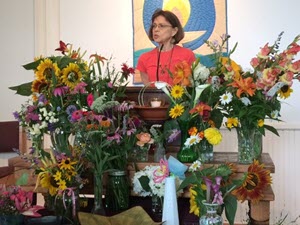
HUU Sermon Archives
The Gnostic Paul
By Beryl Lawson
May 6, 2007
 The
following is more or less an outline of the service called The Gnostic Paul, presented
to the HUU congregation.
The
following is more or less an outline of the service called The Gnostic Paul, presented
to the HUU congregation.
May 13, 2007 - The study of the early Christian Church is fascinating on many levels. One delves into the old testament, the new, idea of miracle, metaphor and last but hardly least politics.
A few definitions: Gnostic comes from the Greek word for knowledge. It is not knowledge of things, as in, “that is a tree,” but rather as in “I know you.” Truly knowing in the Gnostic sense of the word was to know oneself and by extension, to know God.
Ancient Mystery Schools Hindu, Middle Eastern, Greek, Egyptian. All messengers had two gospels- one for the common and one for the more serious. Jesus- parables- not discrimination. One has to be ready for deeper insights. Initiation into these mysteries was a long process of self examination and study of the laws of nature before one can see deeply into life.
Who was Jesus? Jesus was a Nazarene, initiated into the mysteries of that occult school. Life in Egypt. Mystery of death– while alive tomb of Cheops crucifixion and resurrection. He became Jesus the Christ, the anointed one, the enlightened One.
The crucifixion and resurrection of Jesus is the pivotal doctrine of the Christian faith. There is no arguing about it now ( to be Christian one declares his belief in the Nicene Creed) but in the time after the death of Jesus it was the topic of serious discussion and debate. Did Jesus actually rise from the dead? Did he come back to life in a physical body that could be touched like our bodies can be touched? Or was the resurrection a story told to create myth around which people could place their faith?
Those who believed in the literal resurrection of Jesus’ body were the followers of Peter who claimed to be the “rock” upon which the church would be founded. From this conviction arose the belief in the direct descent of authority to the apostles and from them to the bishops of the church, the one doctrine and the establishment of the one catholic church and the literal raising of the dead at the end time.
But here comes Paul. Paul was not too nice a fellow before his vision on the road to Damascus. The story is told that he saw Jesus who spoke to him. He claimed to have a vision directly from God. In fact according to his recollections, corroborated by later facts his vision was in the year 27 when Jesus would have still been alive.
Paul came from Tarsus and was exposed to many of and possibly initiated in one of the Gnostic schools which existed at that time. In fact his mission to the gentiles took him to many of the cities that were rife with Gnostic schools and teaching such as Antioch, Ephisis and Corinth.
It is commonly conceded that much of what is attributed to Paul is, in fact, not his but interpolations by those who tried to make him fit into the orthodox way of looking at things.
Church fathers such as Iraeneus and Tertullian were determined to eliminate any opposition to their view of Christianity. Iraeneus wrote five volumes trying to discredit the teachings of the Gnostics whom he called heretics. To have other ideas than the orthodox doctrines was to undermine Iraeneus’ desire to create one catholic or universal church with one teaching and one authority, namely his. And of course, to have other ideas that were attracting many followers was to undermine his authority.
Until the discovery of the Gospels found at Nag Hammadi in Egypt in 1945 all we ever knew of the Gnostic teachings were what those who called them heretics said. The gospels found were of a Gnostic nature, believed to be hidden by some monks to avoid them being destroyed by order of church authorities.
The Gospel of Truth was written by the Gnostic teacher, Valentinus in the late second or third century. Valentinus claimed to be the student of the student of Paul. His interpretation of Paul’s message puts Paul very squarely in the Gnostic school camp.
According to the Gnostics Jesus seemed to talk of two gods, the god of the old testament, Yahweh, the jealous god who taught an eye for and eye while Jesus taught to turn the other cheek, love those who oppress you. He spoke of his Father in Heaven, who he was one with and that others could also be one with.
The Gnostics said that Yahweh was a lesser god, the demiurge, who had created the material world. He thought he was so mighty that he laid down rules and laws for his followers. He taught that there was original sin and that he was different from people. Gnostics said that man’s troubles were due to ignorance of his true nature and not to sin.
(The story of Adam and Eve and the serpent, the serpent being of a higher nature that tried to save Adam and Eve from the sway of Yahweh by teaching them to eat of the tree of knowledge.)
Paul acknowledged the three parts of humanity’s nature: body, soul and spirit. The Greek words for these parts were hyli-body, psychic or soul and pneuma or spirit. Mankind was trapped in the world of matter and lower mind. Yahweh ruled over those whose attention was to the lower part of their nature. His laws were followed because of fear of the wrath of Yahweh. Jesus’ Father in heaven existed for all who would free themselves from the attachment to the material, selfish and ignorant world and strive to live in the world of spirit, the pneuma. The Father that Jesus speaks of is the One ineffable cause of everything. Jesus says he and his father are one just as you and your father are one. He tells his followers that greater things than he does they can do also. He places the idea of salvation or enlightenment squarely in the hands of the people. They needn’t be afraid of Yahweh. They will do the right thing because they are filled with the higher light of the father of all.
Paul used metaphor and language addressed to those who were on the path to enlightenment. He spoke of Jew and Gentile, meaning those who were psychic, or under the law of Yahweh and Gentile those who were of the nature of pneuma or the spirit. Male and female were key words to refer to the inherent nature of all things in the universe. The male being that which plants the seed, the female who brings to fruition the images of the One cause. The female nature was useless without the male and the other way around. Gnostics were very egalitarian as dealing with men and women.
Paul spoke in Gnostic terms. He writes that he longs to speak to his followers but must do it in person. Spiritual knowledge had to passed from mouth to ear, at low breath. ..
Circumcision was a process of cutting one’s self off from the lower part of one’s nature. To be a true Jew was to look at circumcision as a spiritual process not a physical one.
Paul completely denied the resurrection of the physical body. Baptism and resurrection were processes, not of the body but of the inner portion of man’s nature. To be baptized was to wash away the attachment to the material world. To die to the psychic nature and be resurrected or born again into the world of spirit. To claim to now be baptized was not enough. Just because one said he was of the spiritual nature did not make it so. One had to strive to live up to the teachings and follow the example of the Christ.
Where did Jesus fit into all this for Paul? Jesus the Christ was the teacher, the guide who could help those who would reach to greater things than he himself did. God, the Father was one and everyone and thing was a part of that great one. To know oneself was to know God. To know God was to know oneself in the deepest sense of the word.
Elaine Pagel’s the Gnostic Paul is a treasure of quotes from Paul’s letters interpreted from the Gnostic point of view. Orthodox Christians would debate it but there is evidence that there is more than one way to view the teachings of those early Christians than has been offered in the churches.
What value has all of this information have to UU’s ?
We have given up outer authority, we see similarities of basic teachings of all religions- We search for truth and meaning. But to agree with ideas expressed is only the first step- whatever we follow- the true meaning can only be found within. To truly know that I and my Father are one or That thou art our actions take on broader meaning. We see ourselves as part of one whole, the Cause of which is beyond and yet within all and we need to act from that basis. We too can become as Jesus the Christ or Buddha the Enlightened One. But if we try we need to be prepared to face the opposition of those who would make everyone follow their way, the way of the material world, the world of illusion. Within us all resides the Spirit, a portion of the Divine Cause of all that is. Trying to act from that basis we can truly change the world.
For the latest sermons and events at HUU, visit our Community Cafe.
Inclement
Weather Policy
Worship
Service Materials


UUs on YouTube
Our denomination has an official presence on YouTube! The Unitarian Universalist Association's YouTube site includes several videos and lots of interesting commentary.
Harrisonburg Unitarian Universalists 4101 Rawley Pike | Harrisonburg,
VA 22801
Mailing Address: | PO Box 96 | Harrisonburg, VA 22803
| (540) 867-0073 | Webmaster
HUU is a member of the Southern
Region of the Unitarian Universalist
Association
Privacy Policy &
Disclaimer
Site Design & Maintainence : Expression
Web Tutorials & Templates


